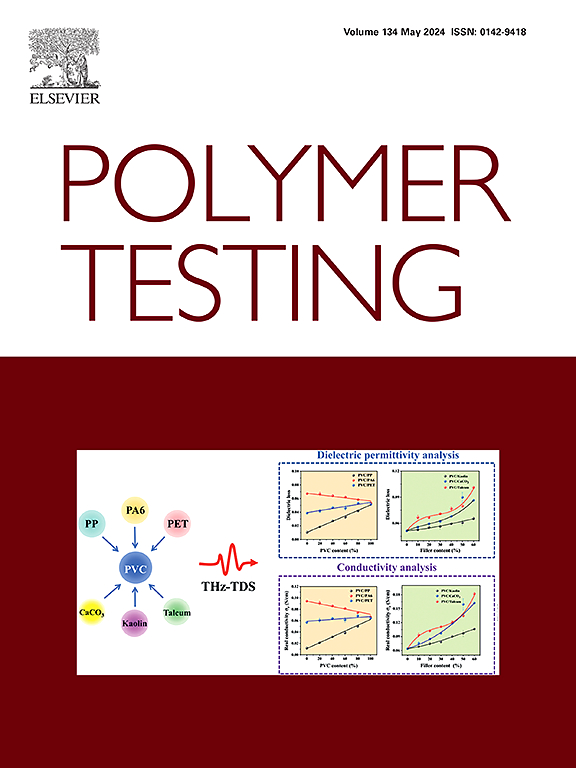Correlations between micro mechanical analyses and macro-scale mechanical properties of PPS/basalt fiber composites designed from commingled yarns
IF 6
2区 材料科学
Q1 MATERIALS SCIENCE, CHARACTERIZATION & TESTING
引用次数: 0
Abstract
To reduce the environmental impacts of the transportation while enhancing safety and fuel efficiency, the development of lightweight, high-performance composites is imperative. To meet this challenge, polyphenylene sulfide (PPS) composites reinforced with basalt fibers (BF) are investigated with a focus on advanced manufacturing techniques via commingled yarns (CY). In fact, basalt fiber-reinforced polymer composites (FRPCs) are promising candidates across diverse industrial -from automotive to aerospace-owing to their superior mechanical properties and thermal stability. This work bridges the gap between the micro and the macro-mechanical performance of PPS/basalt fiber yarns and their composites by systematically evaluating the key role of fiber-matrix interface. Two different sizing formulations were compared against unsized fiber -one based on polyamide-polyurethane and epoxy-unsaturated polyester. Comprehensive surface characterization including chemical composition analysis, micro-tensile testing, wettability, and morphology assessments, was performed to evaluate micro-scale performance. Pull-out adhesion test quantified improvements in the interfacial shear strength (IFSS) from up to 360 % relative to unsized fibers. At the macro-scale, interlaminar shear strength (ILSS) tests established a quantitative relationship with micro-scale phenomena, revealing a 60 % enhancement in mechanical performance when using the optimal film former. Lastly Weibull statistical analyses were performed to examine the role of sizing during CY processing on fiber failure distribution, demonstrating the effective protection provided to fibers during processing and distinguishing major differences between sizing formulation. Collectively, these results provide valuable insights for the design of high-performance composites based on basalt fibers and a PPS matrix.
混纺纱PPS/玄武岩纤维复合材料微观力学分析与宏观力学性能的相关性
为了减少交通对环境的影响,同时提高安全性和燃油效率,开发轻质、高性能复合材料势在必行。为了应对这一挑战,研究了玄武岩纤维(BF)增强聚苯硫醚(PPS)复合材料,重点研究了混纺纱(CY)的先进制造技术。事实上,玄武岩纤维增强聚合物复合材料(frpc)由于其优异的机械性能和热稳定性,在从汽车到航空航天的各种工业领域都是很有前途的候选者。本研究通过系统评价纤维-基体界面的关键作用,弥补了PPS/玄武岩纤维纱线及其复合材料微观力学性能与宏观力学性能之间的差距。对比了两种不同的上浆配方——聚酰胺-聚氨酯和环氧树脂-不饱和聚酯。综合表面表征,包括化学成分分析、微拉伸测试、润湿性和形貌评估,以评估微尺度性能。与未施胶纤维相比,拉出黏附测试量化了界面剪切强度(IFSS)的提高,最高可达360%。在宏观尺度上,层间剪切强度(ILSS)测试与微观尺度现象建立了定量关系,表明使用最佳成膜剂时力学性能提高了60%。最后,采用威布尔统计分析检验了CY加工过程中施胶对纤维失效分布的作用,证明了在加工过程中对纤维的有效保护,并区分了施胶配方之间的主要差异。总的来说,这些结果为基于玄武岩纤维和PPS矩阵的高性能复合材料的设计提供了有价值的见解。
本文章由计算机程序翻译,如有差异,请以英文原文为准。
求助全文
约1分钟内获得全文
求助全文
来源期刊

Polymer Testing
工程技术-材料科学:表征与测试
CiteScore
10.70
自引率
5.90%
发文量
328
审稿时长
44 days
期刊介绍:
Polymer Testing focuses on the testing, analysis and characterization of polymer materials, including both synthetic and natural or biobased polymers. Novel testing methods and the testing of novel polymeric materials in bulk, solution and dispersion is covered. In addition, we welcome the submission of the testing of polymeric materials for a wide range of applications and industrial products as well as nanoscale characterization.
The scope includes but is not limited to the following main topics:
Novel testing methods and Chemical analysis
• mechanical, thermal, electrical, chemical, imaging, spectroscopy, scattering and rheology
Physical properties and behaviour of novel polymer systems
• nanoscale properties, morphology, transport properties
Degradation and recycling of polymeric materials when combined with novel testing or characterization methods
• degradation, biodegradation, ageing and fire retardancy
Modelling and Simulation work will be only considered when it is linked to new or previously published experimental results.
 求助内容:
求助内容: 应助结果提醒方式:
应助结果提醒方式:


